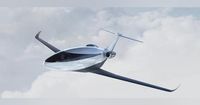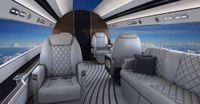The private jet industry, long associated with luxury and exclusivity, is on the brink of a technological revolution that could change the way high flyers experience the skies. Otto Aerospace, a Texas-based aviation startup, has unveiled its ambitious Phantom 3500—a business jet that promises not only to redefine cabin comfort and efficiency but also to challenge the very notion of what it means to look out the window at 40,000 feet.
According to The Wall Street Journal, Otto Aerospace has secured a monumental order from Flexjet, a leading luxury private jet operator. Flexjet has committed to purchasing 300 Phantom 3500 jets over a six to eight-year period, with the first deliveries scheduled for 2030. This deal, valued at approximately $5.85 billion based on market pricing, is among the largest aircraft orders in the history of business aviation, as reported by The Wall Street Journal and echoed by Axios and other industry sources.
What sets the Phantom 3500 apart isn’t just its price tag or the scale of the order—it's the aircraft’s radical windowless design. Gone are the traditional portholes that have graced passenger cabins for decades. In their place, Otto Aerospace has introduced six-foot-tall digital panes that wrap around the teardrop-shaped cabin. These high-definition displays, powered by external high-resolution cameras, provide a panoramic, real-time virtual view of the world outside. As Otto Aerospace CEO Paul Touw put it, “You no longer have to lean over and look out the window. You could sit in our seat and look at the entire world around you…It is surreal.”
The Phantom 3500’s cabin, measuring 22 feet long and 7.5 feet wide, offers a height of nearly six and a half feet—ample space for its eight to nine passengers to stretch out in comfort. The jet’s futuristic digital windows are designed to appeal especially to tech-savvy younger generations who value immersive experiences and cutting-edge innovation. As reported by Axios, the panoramic views promise to make passengers feel as though they’re suspended in the sky, blurring the line between reality and virtuality.
But the move to a windowless cabin isn’t without controversy. Some critics, reacting on social media to the news, have been quick to voice their skepticism. “No windows? Blimey, what’s next—flying in a big tin can?” exclaimed one user on X, as cited by The Wall Street Journal. Others have questioned whether digital views can truly replace the visceral thrill of gazing out at the clouds or the landscape below. “Give me a proper view and a bit of fresh air over fancy shapes any day!” another critic scoffed. Still, the allure of luxury and innovation remains strong, with one commentator wryly observing, “No windows, new shape, but luxury always finds a way to sell.”
Beyond the cabin’s aesthetics, Otto Aerospace’s design is driven by a commitment to efficiency and sustainability. The Phantom 3500 boasts transonic super-laminar flow architecture and is constructed using precision all-carbon-fiber composites. According to company claims reported by Private Jet Card Comparisons and The Wall Street Journal, these features will slash fuel consumption by over 60% compared to current business jets. If equipped with sustainable diesel engines, fuel use could be reduced by as much as 90%—a staggering leap forward in an industry grappling with its environmental footprint.
The jet’s powerplants will come from Williams Aerospace, a name synonymous with reliability in the business aviation sector. The Phantom 3500 is designed for speed, efficiency, and operational flexibility, promising shorter runway access and more cabin space than its competitors in the super-midsize segment.
For Flexjet, this order is more than just a fleet expansion—it’s a statement of intent. Flexjet Chairman Kenn Ricci said, “For 30 years, Flexjet has led through innovation opposed to imitation, introducing tomorrow’s standards, not reacting to yesterday’s expectations.” He continued, “The Phantom 3500 exemplifies that approach perfectly, marking a bold step into a future where an aircraft’s efficiency and sustainability stand alongside speed, comfort, and range as defining standards.” Ricci also highlighted that the partnership with Otto Aerospace further cements Flexjet’s leadership role in delivering the future of luxury private aviation to its fractional aircraft owners.
This isn’t Flexjet’s only major move this year. Earlier, the company placed a $7 billion order with Embraer and unveiled its first Gulfstream G700, aiming to nearly double its fleet to over 600 aircraft by the start of the next decade. The Phantom 3500 order, however, stands out both for its size and its technological ambition.
Otto Aerospace, headquartered in Fort Worth, Texas, brings together a team of industry veterans from aerospace giants like Boeing, Textron, General Dynamics, and Lockheed. Their goal is nothing short of transforming private and regional aviation through clean-sheet aircraft design. The Phantom 3500 is the company’s flagship—a plane that, if it delivers on its promises, could set new benchmarks for efficiency, sustainability, and passenger experience.
The timeline for the Phantom 3500 is ambitious. Otto Aerospace has already built a full-size mock-up for industry conferences, but the jet’s maiden flight isn’t scheduled until 2027. After that, the company will seek FAA certification, with the first customer deliveries planned for 2030. If all goes according to plan, the Phantom 3500 could play a key role in helping the aviation industry meet its net-zero emissions goals by 2050.
The scale of the Flexjet order has not gone unnoticed. As The Wall Street Journal reported, it is “one of the largest aircraft orders to an OEM in business aviation history.” The deal’s value—estimated at $5.85 billion, or about $19.5 million per aircraft—reflects the industry’s confidence in both the plane’s commercial prospects and Otto Aerospace’s ability to deliver on its vision.
Still, for all the excitement, questions remain. Will passengers embrace the windowless cabin, or will nostalgia for traditional views win out? Can Otto Aerospace maintain its aggressive development schedule and achieve the promised efficiencies in real-world operations? And will the Phantom 3500’s innovations prompt established manufacturers to rethink their own design philosophies?
For now, the aviation world is watching closely. The Phantom 3500 represents a bold gamble on the future of private flight—one that could make the familiar window seat a relic of the past, replaced by a digital panorama and a new standard for sustainable luxury in the skies.
As the countdown to 2027 begins, one thing is clear: the race to reinvent the private jet is officially on, and Otto Aerospace, with Flexjet at its side, is leading the charge.



